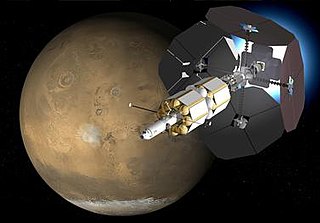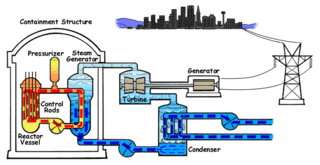Related Research Articles

Interstellar travel is the hypothetical travel of spacecraft from one star system, solitary star, or planetary system to another. Interstellar travel is expected to prove much more difficult than interplanetary spaceflight due to the vast difference in the scale of the involved distances. Whereas the distance between any two planets in the Solar System is less than 55 astronomical units (AU), stars are typically separated by hundreds of thousands of AU, causing these distances to typically be expressed instead in light-years. Because of the vastness of these distances, non-generational interstellar travel based on known physics would need to occur at a high percentage of the speed of light; even so, travel times would be long, at least decades and perhaps millennia or longer.

Spacecraft propulsion is any method used to accelerate spacecraft and artificial satellites. In-space propulsion exclusively deals with propulsion systems used in the vacuum of space and should not be confused with space launch or atmospheric entry.

A nuclear thermal rocket (NTR) is a type of thermal rocket where the heat from a nuclear reaction, often nuclear fission, replaces the chemical energy of the propellants in a chemical rocket. In an NTR, a working fluid, usually liquid hydrogen, is heated to a high temperature in a nuclear reactor and then expands through a rocket nozzle to create thrust. The external nuclear heat source theoretically allows a higher effective exhaust velocity and is expected to double or triple payload capacity compared to chemical propellants that store energy internally.

A fusion rocket is a theoretical design for a rocket driven by fusion propulsion that could provide efficient and sustained acceleration in space without the need to carry a large fuel supply. The design requires fusion power technology beyond current capabilities, and much larger and more complex rockets.

An antimatter rocket is a proposed class of rockets that use antimatter as their power source. There are several designs that attempt to accomplish this goal. The advantage to this class of rocket is that a large fraction of the rest mass of a matter/antimatter mixture may be converted to energy, allowing antimatter rockets to have a far higher energy density and specific impulse than any other proposed class of rocket.

The Variable Specific Impulse Magnetoplasma Rocket (VASIMR) is an electrothermal thruster under development for possible use in spacecraft propulsion. It uses radio waves to ionize and heat an inert propellant, forming a plasma, then a magnetic field to confine and accelerate the expanding plasma, generating thrust. It is a plasma propulsion engine, one of several types of spacecraft electric propulsion systems.

Nuclear pulse propulsion or external pulsed plasma propulsion is a hypothetical method of spacecraft propulsion that uses nuclear explosions for thrust. It originated as Project Orion with support from DARPA, after a suggestion by Stanislaw Ulam in 1947. Newer designs using inertial confinement fusion have been the baseline for most later designs, including Project Daedalus and Project Longshot.
Antimatter-catalyzed nuclear pulse propulsion is a variation of nuclear pulse propulsion based upon the injection of antimatter into a mass of nuclear fuel to initiate a nuclear chain reaction for propulsion when the fuel does not normally have a critical mass.

A magnetohydrodynamic drive or MHD accelerator is a method for propelling vehicles using only electric and magnetic fields with no moving parts, accelerating an electrically conductive propellant with magnetohydrodynamics. The fluid is directed to the rear and as a reaction, the vehicle accelerates forward.

Project Orion was a study conducted in the 1950s and 1960s by the United States Air Force, DARPA, and NASA into the viability of a nuclear pulse spaceship that would be directly propelled by a series of atomic explosions behind the craft. Early versions of the vehicle were proposed to take off from the ground; later versions were presented for use only in space. The design effort took place at General Atomics in San Diego, and supporters included Wernher von Braun, who issued a white paper advocating the idea. Non-nuclear tests were conducted with models, but the project was eventually abandoned for several reasons, including the 1963 Partial Test Ban Treaty, which banned nuclear explosions in space, and concerns over nuclear fallout.

Nuclear propulsion includes a wide variety of propulsion methods that use some form of nuclear reaction as their primary power source. The idea of using nuclear material for propulsion dates back to the beginning of the 20th century. In 1903 it was hypothesized that radioactive material, radium, might be a suitable fuel for engines to propel cars, planes, and boats. H. G. Wells picked up this idea in his 1914 fiction work The World Set Free. Many aircraft carriers and submarines currently use uranium fueled nuclear reactors that can provide propulsion for long periods without refueling. There are also applications in the space sector with nuclear thermal and nuclear electric engines which could be more efficient than conventional rocket engines.

Laser propulsion is a form of beam-powered propulsion where the energy source is a remote laser system and separate from the reaction mass. This form of propulsion differs from a conventional chemical rocket where both energy and reaction mass come from the solid or liquid propellants carried on board the vehicle.
The fission-fragment rocket is a rocket engine design that directly harnesses hot nuclear fission products for thrust, as opposed to using a separate fluid as working mass. The design can, in theory, produce very high specific impulse while still being well within the abilities of current technologies.
A pure fusion weapon is a hypothetical hydrogen bomb design that does not need a fission "primary" explosive to ignite the fusion of deuterium and tritium, two heavy isotopes of hydrogen used in fission-fusion thermonuclear weapons. Such a weapon would require no fissile material and would therefore be much easier to develop in secret than existing weapons. Separating weapons-grade uranium (U-235) or breeding plutonium (Pu-239) requires a substantial and difficult-to-conceal industrial investment, and blocking the sale and transfer of the needed machinery has been the primary mechanism to control nuclear proliferation to date.
Similar to how the fission-fragment rocket produces thrust, a fission fragment reactor is a nuclear reactor that generates electricity by decelerating an ion beam of fission byproducts instead of using nuclear reactions to generate heat. By doing so, it bypasses the Carnot cycle and can achieve efficiencies of up to 90% instead of 40-45% attainable by efficient turbine-driven thermal reactors. The fission fragment ion beam would be passed through a magnetohydrodynamic generator to produce electricity.
ICAN-II was a proposed crewed interplanetary spacecraft that used the antimatter-catalyzed micro-fission (ACMF) engine as its main form of propulsion. The spacecraft was designed at Penn State University in the 1990s as a way to accomplish a crewed mission to Mars. The proposed ACMF engine would require only 140 nanograms of antiprotons in conjunction with traditional fissionable fuel sources to allow a one-way transit time to Mars of 30 days. This is a considerable improvement over many other forms of propulsion that can be used for interplanetary missions, due to the high thrust-to-weight ratio and specific impulse of nuclear fuels. Some downsides to the design include the radiation hazards inherent to nuclear pulse propulsion, as well as the limited availability of the antiprotons used to initialize the nuclear fission reaction. Even the small amount required by the ACMF engine is equal to the total antimatter production at the facilities CERN and Fermilab over many years, although these create antimatter only as a byproduct of physics experiments, not as a goal. ICAN-II is similar to the Project Orion design put forth by Stanislaw Ulam in the late 1950s. The Orion was intended to be used to send humans to Mars and Venus by 1968. The ICAN-II also, in a sense, utilizes nuclear "bombs" for thrust. However, instead of regular fission bombs like the Orion would utilize, ICAN-II uses what are, essentially, many tiny hydrogen bombs, set off by a stream of anti-protons. Ecological concerns would probably require that ICAN-II be assembled in space.
Nuclear gas-core-reactor rockets can provide much higher specific impulse than solid core nuclear rockets because their temperature limitations are in the nozzle and core wall structural temperatures, which are distanced from the hottest regions of the gas core. Consequently, nuclear gas core reactors can provide much higher temperatures to the propellant. Solid core nuclear thermal rockets can develop higher specific impulse than conventional chemical rockets due to the low molecular weight of a hydrogen propellant, but their operating temperatures are limited by the maximum temperature of the solid core because the reactor's temperatures cannot rise above its components' lowest melting temperature.

Magnetized liner inertial fusion (MagLIF) is an emerging method of producing controlled nuclear fusion. It is part of the broad category of inertial fusion energy (IFE) systems, which drives the inward movement of fusion fuel, thereby compressing it to reach densities and temperatures where fusion reactions occur. Previous IFE experiments used laser drivers to reach these conditions, whereas MagLIF uses a combination of lasers for heating and Z-pinch for compression. A variety of theoretical considerations suggest such a system will reach the required conditions for fusion with a machine of significantly less complexity than the pure-laser approach. There are currently at least two facilities testing feasibility of the MagLIF concept, the Z-machine at Sandia Labs in the US and Primary Test Stand (PTS) located in Mianyang, China.

Salvatore Cezar Pais is an American aerospace engineer and inventor, currently working for the United States Space Force. He formerly worked at the Naval Air Station Patuxent River. His patent applications for the US Navy attracted attention for their potential energy-producing applications, but also doubt about their feasibility, and speculation that they may be scams, pseudoscience, or disinformation intended to mislead the United States' adversaries.
The history of nuclear fusion began early in the 20th century as an inquiry into how stars powered themselves and expanded to incorporate a broad inquiry into the nature of matter and energy, as potential applications expanded to include warfare, energy production and rocket propulsion.
References
- ↑ "Mini-Mag Orion (Andrews Space)". Archived from the original on January 13, 2006. Retrieved 2007-09-21.
{{cite web}}: CS1 maint: bot: original URL status unknown (link) - ↑ Aerospace Engineering, SAEAerospace, July 2003, page 19, written by Kevin Jost